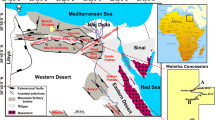Abstract
This work uses high-quality 3D seismic data from the historic oil-producing province of NE India in the Upper Assam Basin for the investigation of structural architecture and textural characteristics that have modulated the Barail and Tipam Formations of the Tertiary successions. The seismic volume was structurally conditioned to improve the contrast at seismic reflectors and thereby preserving their lateral continuity. The conditioned data are interpreted in combination with seismic attributes to examine the seismic textural responses in the interval of interest between the Barail and Tipam formations. The study brings out that the Barail coal-shale unit is associated with deformed, wavy, chaotic and heterogeneous textures, which suggest a deeper basinal condition prevailing during the deposition. However, molassic texture associated with less chaotic and high homogeneity of reflections indicate the occurrence of fluviatile environment that prevailed during the deposition of the Tipam sandstone unit. It is observed that structural compartments within the Miocene interval act as different trap networks for encasing migrated hydrocarbons from the Oligocene source interval. The finding establishes a relationship between the structural and depositional set-ups within the litho-units of the Tertiary successions for plausible hydrocarbon accumulation in the upper Assam basin.
Similar content being viewed by others
References
Alam, J., Gogoi, T. and Chatterjee, R. (2021) Geomechanical characterization of subsurface formations with stress rotation in Assam Gap, Northeast India. Jour. Earth Syst. Sci., v.30(3), pp.1–14.
Bharali, B. and Borgohain, P. (2013) Few characteristics of Tipam sandstone formation within oilfield areas of Upper Assam—a study based on wireline log data. Jour. Earth Sci., Spec. Vol., pp.36–45.
Bhandari, L.L., Fuloria, R.C. and Sastri, V.V. (1973) Stratigraphy of Assam Valley, India. AAPG Bull., v.57(4), pp.642–654.
Borgohain, S., Das, J., Saraf, A.K., Singh, G. and Baral, S.S. (2017). Structural controls on topography and river morphodynamics in Upper Assam Valley, India. Geodinamica Acta, v.29(1), pp.62–69.
Chopra, S. and Marfurt, K.J. (2007) Seismic attributes for prospect identification and reservoir characterization. Society of Exploration Geophysicists and European Association of Geoscientists and Engineers.
DasGupta, A.B. and Biswas, A.K. (2000) Geology of Assam. Geological Society of India, Banglore.
Gao, D. (2007) Application of three-dimensional seismic texture analysis with special reference to deep-marine facies discrimination and interpretation: Offshore Angola, west Africa. AAPG Bull., v.91(12), pp.1665–1683.
Gogoi, T. and Chatterjee, R. (2019) Estimation of petrophysical parameters using seismic inversion and neural network modeling in Upper Assam basin, India. Geoscience Frontiers, v.10(3), pp.1113–1124.
Gogoi, T. and Chatterjee, R. (2021). An integrated petrophysical and rock physics analysis for reservoir characterization study in parts of Upper Assam basin, India. Arabian Jour. Geosci., v.14(20), pp.1–11.
Goswami, D.C. (1985) Brahmaputra River, Assam, India: Physiography, basin denudation and channel aggradation. Water Res., v.21, pp.959
Kent, W.N. and Dasgupta, U. (2004) Structural evolution in response to fold and thrust belt tectonics in northern Assam. A key to hydrocarbon exploration in the Jaipur anticline area. Marine Petrol. Geol., v.21(7), pp.785–803.
Kumar P.C. and Mandal, A. (2017) Enhancement of fault interpretation using multi-attribute analysis and artificial neural network (ANN) approach: A case study from Taranaki Basin, New Zealand. Exploration Geophysics, v.49(3), pp.409–424.
Kumar P.C., Sain, K. (2018) Attribute amalgamation-aiding interpretation of faults from seismic data: An example from Waitara 3D prospect in Taranaki basin off New Zealand. Jour. Appl. Geophys., v.159, pp.52–68.
Kumar, P.C., Omosanya, K.O. and Sain, K. (2019) Sill Cube: An automated approach for the interpretation of magmatic sill complexes on seismic reflection data. Jour. Marine Petrol. Geol., v.100, pp.60–84.
Kumar, P.C. and Sain, K. (2020) A machine learning tool for interpretation of Mass Transport Deposits from seismic data. Nature Scientific Reports, v.10(1), pp.1–10.
Kumar, P.C., Alves, T.M. and Sain, K. (2021) Forced folding in the Kora Volcanic Complex, New Zealand: A case study with relevance to the production of hydrocarbons and geothermal energy. Geothermics, v.89, 101965.
Mandal, K. and Dasgupta, R. (2013) Upper Assam basin and its basinal depositional history. In: SPG 10th Biennial International Conference and Exposition, Kochi, India, v.292, pp.1–7
Mathur, N., Raju, S.V. and Kulkarni, T.G. (2001) Improved identification of pay zones through integration of geochemical and log data: A case study from Upper Assam basin, India. AAPG Bull., v.85(2), pp.309–323.
Nandy, D.R. (2001) Geodynamics of Northeastern India and the adjoining regions. Revised Edition, Scientific Book Centre, Dispur, Guwahati, Assam, 272p.
Pahari, S., Singh, H., Prasad, I.V.S.V., Singh, R.R. (2008) Petroleum systems of upper Assam Shelf, India. Society of Petroleum Geophysicist, India. Geo-Horizons, pp.14–21.
Sahoo, M. and Gogoi, K.D. (2011). Structural and Sedimentary Evolution of Upper Assam Basin, India and Implications on Hydrocarbon Prospectivity. In: 2nd South Asian Geoscience Conference and Exhibition, GEO India, pp.1–6.
Verma, R.K. and Gupta, R.P. (1973) Relationship of gravity anomalies and tectonics in Assam. Tectonophysics, v.18, pp.19–31.
Visvanath, S.N. (1997) A hundred years of oil: A narrative account of the search for oil in India. New Delhi: Vikas Publishing House Pvt. Ltd., pp.175.
Wandrey, C.J. (2004) Sylhet-Kopili/Barail-Tipam composite total petroleum system, Assam geologic province, India. US Department of the Interior, USGS, pp.1–17.
Acknowledgements
The Director, WIHG is acknowledged for according permission to publish this work. National Data Repository-DGH, India is thanked for providing seismic data to pursue this research at Seismic Interpretation Laboratory (SIL) of WIHG, Dehradun. dGB Earth Sciences™(OpendTect™ v6.6.4) and DUG Insight are vehemently thanked for providing the seismic interpretation suites for this academic research. KS acknowledges DST-SERB for according him with the JC Bose National Fellowship. The authors thank the Editor-in-Chief and an anonymous reviewer for their constructive comments on the earlier version of the manuscript. This is a Wadia Institute contribution no. WIHG/0231.
Author information
Authors and Affiliations
Corresponding author
Rights and permissions
About this article
Cite this article
Kumar, P.C., Sain, K. Seismic Texture of Tertiary Successions: Insights from Tipam and Barail Formations in the Upper Assam Basin, NE India. J Geol Soc India 98, 1671–1679 (2022). https://doi.org/10.1007/s12594-022-2236-2
Received:
Accepted:
Published:
Issue Date:
DOI: https://doi.org/10.1007/s12594-022-2236-2




